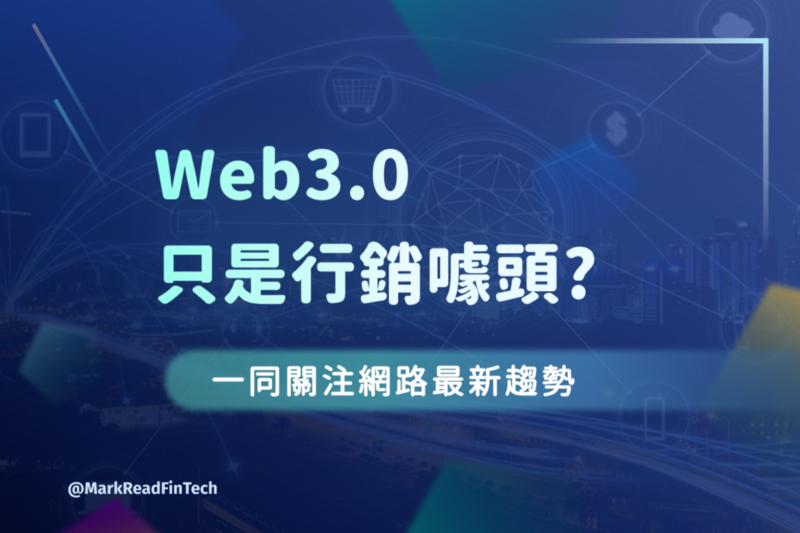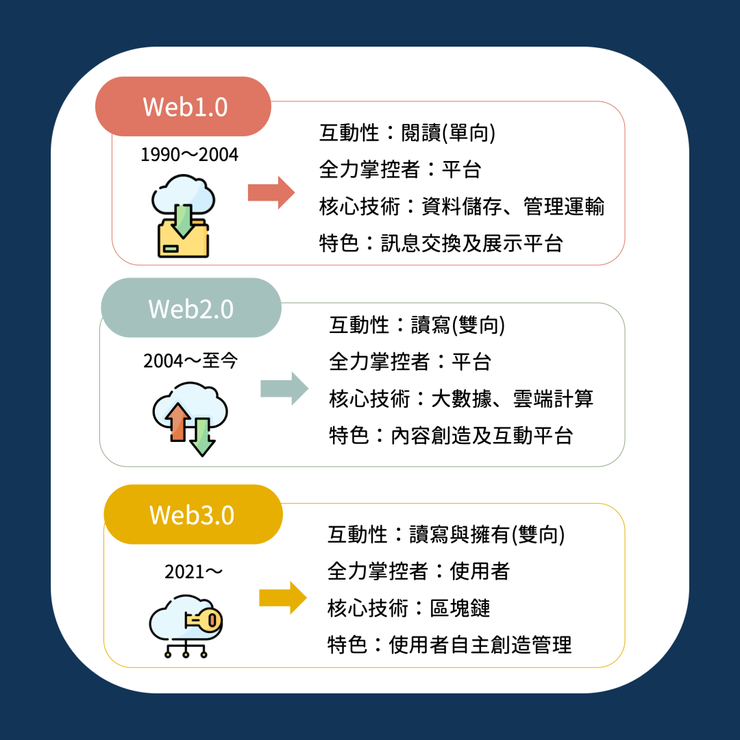Web 3.0 is just a marketing gimmick?

According to Google trends, Web3.0 has soared in global searches in recent months, and it has also been selected by Reuters as the top 10 technology buzzwords in 2021. Successfully caused a heated debate between supporters and opponents. Tesla CEO Elon Musk said more bluntly, "Has anyone seen Web3.0? I can't find it." And Jack Dorsey, one of the founders of Twitter, also said that Web3.0 is just a marketing gimmick, just a change label. However, before discussing whether Web 3.0 is a hype or a revolution, perhaps it is time to understand what Web 3.0 is?
1. Where does Web3.0 come from?
(1) Web1.0
Web1.0 refers to the earliest Internet era. Users can search for various information and send and receive E-mails on the Internet. However, most of them belong to static pages during this period. Interactive, only the owner of the website can update the page with new information. Simply put, Web 1.0 is like bringing information from paper to the Internet, allowing users to browse all kinds of information at will without the constraints of time and space.
(2) Web2.0
In Web 2.0, in addition to being able to search for information on the Internet, different from Web 1.0, users can easily interact with others through the Internet, changing from the original one-way communication to two-way communication, and various applications are also born. A large number of user-generated content (USG) has made the Internet have an explosive growth, and social media such as Youtube and Facebook have become the darling of the new era. The pursuit of click-through rate and the revenue from advertising have become the mainstay of today's Internet companies. profit model. Make the Internet a place for active participation rather than passive consumption.
But new problems also arise, as users cannot decide and control the data and how it is stored, which is owned and controlled by the companies responsible for these platforms. It can be said that these companies control all the rules of the game, and they have absolute power over platform users and third-party developers. Data is the core asset of these companies, allowing them to profit by mastering information, but users have no right to participate in it, which is why these platform companies are now called "tech giants".
(3) Web3.0
Web3.0 is an idea put forward by Ethereum founder Gavin Wood in 2014. He believes that the world should have a low threshold, uncensored and verifiable to protect the information flow and financial flow of network users. So far, Web 3.0 still lacks a specific definition, but its core concept is inextricably linked to the "decentralization" in blockchain technology. It is hoped that it will focus on individuals, so that the Internet can not be controlled by a few enterprises and governments. , and return the ownership of personal data to the user.
Therefore, Web3.0 brings a more open, fair and secure network, but this is not an "upgraded version" of Web2.0, but users can own the content they contribute, and they can also get a certain degree of return. In terms of privacy, users will be able to know the boundaries and uses of these data, and have decision-making power over these data.
In simple terms, users can connect to the Internet without intermediary services such as Google, Apple or Facebook, but control various parts of the network themselves. In the future, users may only need to pass an encrypted wallet address. Use each website freely.
Web1.0, 2.0, 3.0 to one ratio

2. Why Web3.0 can take advantage of the trend to rise
Web 3.0 is not a new concept, but it has become a hot topic of discussion in 2021, mainly for the following reasons.
● Privacy concerns
In the world of Web 2.0, in order to use the platforms of various websites, users must register multiple accounts and provide personal data. However, the problem of personal data leakage often occurs, and websites will also use cookies and other users. Footprints are used to describe the appearance of users and sell them to advertisers for profit. Therefore, it seems that users can use various websites and applications for free, but they are actually being sold like commodities.
● Security issues
Web 2.0 websites are often owned by a third party, in other words, all user content on the website can disappear overnight. Since most everything on Web 3.0 is on the blockchain, the decentralized mechanism makes the process largely tamper-proof and transparent, giving people a tendency to trust such sites.
● Catalyzed by concepts such as "blockchain, metaverse"
In the "decentralized" network system of Web 3.0, "blockchain" is mainly used as the core technology; and the Metaverse is essentially the future Internet. Web 3.0 will help promote the use of blockchain systems and Open standards, through the decentralized interface of Web 3.0, break the traditional restrictions on individual users entering and leaving the community and the censorship of content, so that each user can freely participate in it and shuttle in different virtual worlds.
3. Disadvantages and limitations of Web3.0
Web3.0 brings many advantages to users, such as allowing content creators to share profits, but it is not without obstacles in the process of introduction.
● Opposition
Under the centralized Internet model for a long time, users have formed a habit of using it and are used to hosting everything to a centralized third-party platform. They believe that today's Internet has developed to an almost perfect stage, and Web 3.0 seems to be unnecessary. , Web 3.0 has become a new marketing tool.
Under the long-term centralized Internet model, users have formed usage habits and are used to hosting everything to a centralized third-party platform. Opponents believe that today's Internet has developed to an almost perfect stage, and Web 3.0 does not seem to exist. Necessary, Web 3.0 becomes the new marketing tool.
● Technical bottleneck
Compared with the current centralized network, the scalability and efficiency of the decentralized network are lower, and the processing is relatively time-consuming, and the lack of perfect integration or transition with today's web browsers will make most Internet users cannot browse and visit Web3.0 websites smoothly.
● Legal and regulatory risks
A decentralized network that is not regulated and controlled can easily become a breeding ground for low-quality content, and formulating a reasonable regulatory mechanism requires a long period of running-in and exploration, which may lead to a dilemma where there is no “law” to follow.
● Difficult to popularize
At present, applications using Web 3.0 require additional processing steps, software and teaching, and have high development costs in application development, and most successfully developed DApps will only put a very small amount of code in the block. On-chain, so this will create a barrier to widespread adoption in the short term.
Fourth, the practical application of Web3.0
Web 3.0 is still a very new vocabulary, but the applications in related fields have become more and more popular. The most representative applications of Web 3.0 include NFT, DeFi, and token economy. According to the statistics of encrypted data website DappRadar, there are currently more than 8,700 DApps (Decentralized Applications) in operation around the world, including cryptocurrency trading platforms, games, etc.
The BlueSky project developed by Twitter aims to create a decentralized version of social media; in addition, Ubisoft, a major game maker, announced that it will launch the NFT platform Quartz, allowing players to use NFT to trade game items; emerging Web 3.0 creators Platforms are also emerging, such as writing platform Mirror.xyz, NFT music platform Royal, social platform Sapien, etc., reflecting the decentralized technology and giving birth to a colorful era of creator economy.
5. The future development of Web3.0 in Taiwan
Compared with other markets in the region, Taiwan has two major characteristics in the development of the Web3.0 ecosystem
● Market
Taiwan has a huge market for digital games and entertainment. According to App Annie statistics, in 2020, Taiwanese people spent a total of 2.44 billion U.S. dollars in the App Store, which is equivalent to about 2.46 billion U.S. dollars in Indonesia, Thailand, Vietnam, the Philippines, and Malaysia combined. In 2021, Taiwan will catch up with the global NFT boom. On the basis of the huge digital game and entertainment market, more and more Taiwanese blockchain startups will create various products and services with NFT, so that NFT can be used in just one year. received public attention.
● Talent
Taiwan has top scientific and technological talents, which has become the core of Taiwan's development of blockchain, and Taiwan's new startups have also successfully emerged in the global blockchain industry. Since AppWorks launched the first startup accelerator, it has continued to actively combine resources from all parties. At this stage, it is optimistic about the development of AI, blockchain, and Southeast Asia. It has officially formed an alliance with the first-line public chain Flow strategy of blockchain to jointly Promote the blockchain ecosystem and lead the entrepreneurial ecology in the greater Southeast Asia region to continue to advance.
6. Mark's point of view
Mark believes that not every service or industry will move towards the Web3.0 model, and it is necessary to consider whether to embrace a centralized or decentralized architecture. In the past, people chose centralized services because it would be more efficient than a decentralized architecture, but at the same time, it also delivered various powers. However, with the changes of the times, people began to pay attention to the individual voices and values of the group after connecting through the Internet. Only by using a decentralized architecture can certain issues be perfectly realized.
Therefore, looking at the boom of Web 3.0, it is not difficult to understand why some people think that this is just a marketing gimmick. Like the ICO boom in the currency circle in 2017, it blurs the characteristics that are actually useful, and these will pass after a period of time. It will slowly settle down, and even improve the original imperfections.
Like my work? Don't forget to support and clap, let me know that you are with me on the road of creation. Keep this enthusiasm together!

- Author
- More